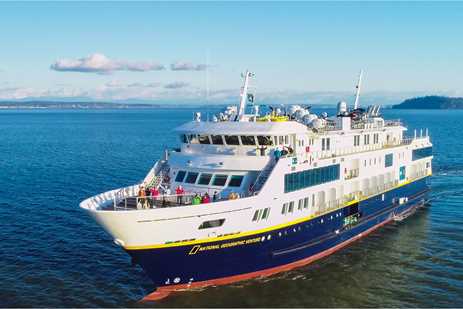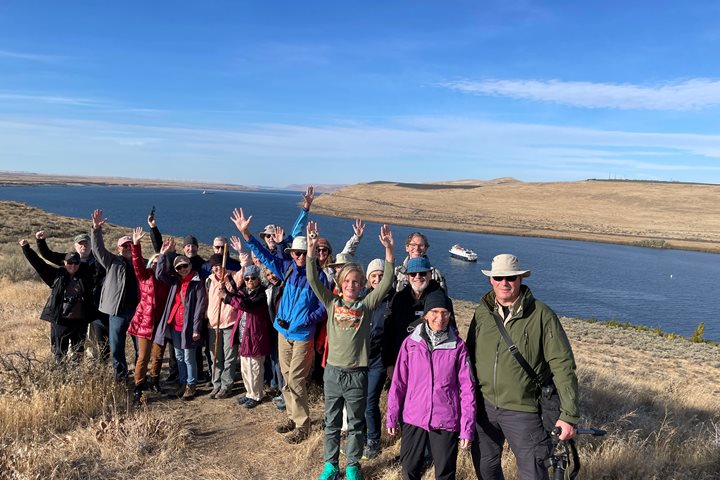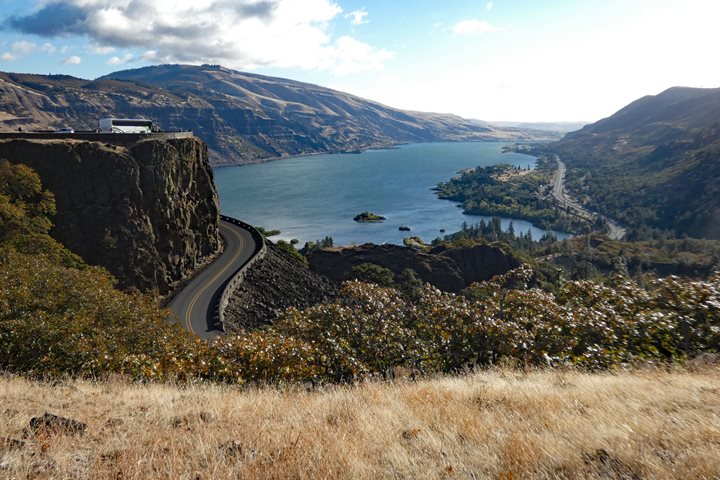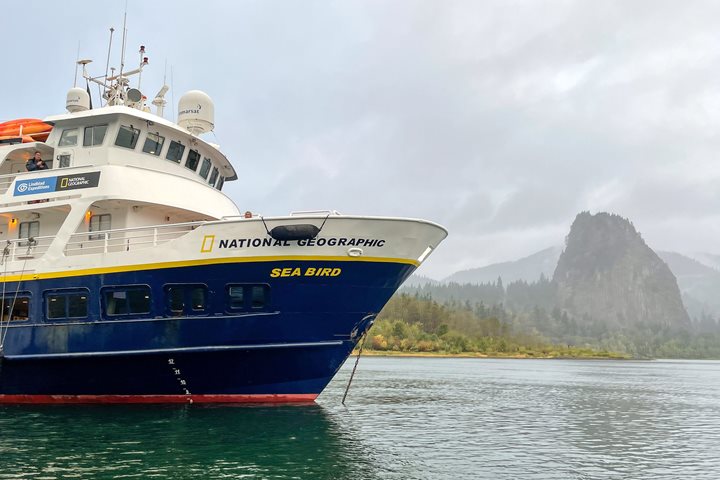Call +1.212.765.7740
With Compliments
Starting in 2023, we are pleased to offer complimentary beer & wine aboard National Geographic Quest, National Geographic Venture, National Geographic Sea Bird, and National Geographic Sea Lion. See our new Free Bar Policy under special offers for details.
|
We're a winner of Conde Nast Traveler's 2022 Readers Choice Awards |
Spring forward into stunning landscapes and compelling history
The Columbia and Snake Rivers take on a new kind of vibrancy in spring. Join us as we cruise spectacularly scenic waterways when wildflowers are blooming, waterfalls are brimming, and salmon-fishing is at its peak. Experience un unmatched perspective on Columbia River Gorge, Hell's Canyon and more aboard our nimble 62-guest expedition ships.

View the full itinerary and take advantage of airfare and solo travel savings in 2023.
Read more
With Compliments
Starting in 2023, we are pleased to offer complimentary beer & wine aboard National Geographic Quest, National Geographic Venture, National Geographic Sea Bird, and National Geographic Sea Lion. See our new Free Bar Policy under special offers for details.
Expedition Highlights
Hike island forest trails in search of wildlife, kayak verdant shorelines, and bike the waterfront of a scenic city—or cruise by Zodiac and visit a mixture of quaint and world-class museums. Options abound for indulging your interests in the Pacific Northwest. Hear the legends and learn the traditions of Native Americans and First Nations through their art or moving performances. Taste the bounty of the region. Dine on salmon straight from local waters, foraged wild mushrooms picked within 50 miles, and provisions delivered directly from farmers along our route.
Go aboard nimble expedition ships perfect for navigating far inland or through tiny bays, islands, and inlets where wildness abounds
Delve into the region’s history of exploration, including Lewis and Clark, and learn about the rich cultures of Native Americans and First Nations
Explore at water level by Zodiac, plus single and tandem kayaks to get closer in places like the calm bays of the San Juan Islands or glassy stretches of the Columbia River
Sample superb locals wines and craft beers and dine on fantastic produce supplied to our chefs by local farms
Create images of the stunning landscapes with help from your Lindblad-National Geographic certified photo instructor
See less Highlights
Our Ships in the Pacific Northwest
Life Aboard
Relax and settle in to life aboard as you cruise the waters of the Pacific Northwest. Your expedition ship offers the absolute best way to access all the sites, culture, and history along the river—without ever having to change hotels or wheel luggage around. We add to that the luxury of comfort with a quality of shipboard life and a philosophy of wellness designed to relax and rejuvenate body, mind, and spirit as you cruise the Pacific Northwest.
01
/
06






01
/
03
Expedition Dining—Then & Now
The Pacific Northwest is known for its incredible bounty and some of the freshest ingredients around. You can look forward to meals that celebrate the region’s world-famous flavors, like a vibrantly pink coho salmon filet, bright green coils of fiddlehead ferns, and a bottle of terroir-rich pinot noir.
Hells Canyon
There's no other way (not even a hike) to get up close with Hells Canyon besides a jet boat ride.
Wildlife & Natural Wonders in the Pacific Northwest
From killer whales to bighorn sheep, the wildlife and scenery of the Pacific Northwest are vastly varied.
Discover the Pacific Northwest

Expedition Highlights
Hike island forest trails in search of wildlife, kayak verdant shorelines, and bike the waterfront of a scenic city—or cruise by Zodiac and visit a mixture of quaint and world-class museums. Options abound for indulging your interests in the Pacific Northwest. Hear the legends and learn the traditions of Native Americans and First Nations through their art or moving performances. Taste the bounty of the region. Dine on salmon straight from local waters, foraged wild mushrooms picked within 50 miles, and provisions delivered directly from farmers along our route.
See more Highlights

Doesn't get better, a brilliant staff.
Stephanie O.
10/27/2022
Read
National Geographic Sea Bird
Crow Butte
National Geographic Sea Bird climbed up the Columbia River. The ship made its way from the temperate rainforest across the deep and narrow basalt cliffs of the Columbia Gorge and into the dry sagebrush-steppe landscape of Crow Butte. The transformation took just a few hours. As the sun rose across the sharply edged riverine lines, guests sipped coffee and enjoyed breakfast. Afterwards, we enjoyed an expert talk on “Soils and Raptors” by naturalist and “Raptor Extraordinaire,” Zoey Greenberg. Emerging from Celilo Falls and the Long Narrows, we shuttled upstream to Crow Butte Island. Guests enjoyed aerobic nature walks around the island in the morning. Returning to National Geographic Sea Bird , guests enjoyed an afternoon of cruising through the Umatilla National Wildlife Refuge and educational presentations on “Salmon, Dams, and the Columbia River Treaty,” by Patrick MacQuarrie, river historian, and “Geology of the Columbia River Basin,” by the multitalented naturalist wizard, Jesse Humbert. Crow Butte and the refuge offered a plethora of birdlife for the guests’ enjoyment, including grebes, great blue herons, double-crested cormorants, American white pelicans, bald eagles, northern harriers, red-tailed hawks, kestrels, and several types of geese, including snow geese, cackling geese, and Canada geese. We also spotted buffleheads, widgeons, mallards, coots, gulls, and several sparrows. While naturalists wooed the “Sea Bird Nation” with natural science and history stories, the ship transited McNary Lock. The lock lifted National Geographic Sea Bird up 75-feet into Lake Wallula, eventually passing Wallula Gap and entering the Snake River by dinner. Once again, National Geographic Sea Bird made the once impossible journey possible. This was first accomplished by Lewis and Clark in 1805 and 1806 on their historic journey to open the West to a young and eager country. Photographers: Patrick MacQuarrie, River Historian and Naturalist ; Dr. Robert Jason, Guest ; and Kim Nesbitt, Photo Instructor
10/26/2022
Read
National Geographic Sea Bird
The Dalles, Oregon
Dawn broke cold but clear with temperatures in the high 40s and partly cloudy skies. It was wonderful weather for an exploration of the transition zone between the temperate rainforest of the past two days and the shrub-steppe that begins here and dominates the landscape heading east.
10/25/2022
Read
National Geographic Sea Bird
Columbia River Gorge & Hood River Valley
Today we had a wonderful introduction to the gorgeous farmland and industry of the Columbia River ecosystem. From experiencing the “Fruit Loop” to a salmon hatchery to a wonderful farm-to-table lunch, it was a beautiful day.
10/24/2022
Read
National Geographic Sea Bird
Astoria, Oregon
Today we awoke eight miles from the Pacific Ocean, as the crow flies, in Astoria, Oregon. This was the saltiest air we will breathe all week. Our excursions for the day included a trip to the Astoria Column, a sensory-filled moment with a California sea lion haul out, a visit to the Columbia River Maritime Museum, and an immersive experience at the famed Cape Disappointment, home to the Lewis and Clark Interpretive Center. Each of these sites highlighted an unforgettable element of the Pacific Northwest, as temperate rainforests captured our rapt attention and introduced us to the genuine beauty of the region. We saw a rough-skinned newt, a northern red-legged frog, two bald eagles, and several black-tailed deer. Sitka spruce towered overhead, and epiphytic ferns catalyzed our understanding of the vegetative wonders growing in this place. Beginning our voyage in such a historically, culturally, and ecologically rich location set a powerful tone and brought our ship community into the arms of a riverine environment that is unique on this planet. Let the adventure continue to unfold. Photographers: Zoey Greenberg, Naturalist , and Patrick MacQuarrie, River Historian
10/22/2022
Read
National Geographic Sea Bird
Astoria, Oregon
An early morning mist covered the bay as guests awoke. After breakfast, guests departed across the iconic steel truss Astoria Bridge on their way to the Lewis and Clark Interpretive Center. After arriving on the Oregon side of the Columbia River, guests began exploring Waikiki Beach with the incoming tide. A connecting trail provided a scenic hike to a cliff with views of the Pacific Ocean and the Columbia River Bar. As the morning sun peeked out from behind the clouds, guests continued on their hike to the Lewis and Clark Interpretive Center. A ranger provided a brief history of the area before guests began a tour of the museum. After learning about the amazing history of the Corps of Discovery, the group returned to the ship for lunch. After lunch, guests left to explore the 30-acre park situated on a hill overlooking the quiet town of Astoria. A small gift store offered balsa wood airplanes, and height-enthusiastic guests adventured 164 steps up the Astoria Column to launch their planes into the brisk fall wind. Upon returning to the buses, guests were transported to an active California sea lion (Zalophus californianus) haul-out. One guest counted approximately 250 individuals basking in the sun on an abandoned dock. After a short ride, guests visited the Columbia River Maritime Museum to explore the huge collection of vessels and historical ephemera from the area. Photographers: Aaron Raymond, Photo Instructor , and Patrick MacQuarrie, River Historian
10/27/2022
Read
National Geographic Sea Bird
Crow Butte
National Geographic Sea Bird climbed up the Columbia River. The ship made its way from the temperate rainforest across the deep and narrow basalt cliffs of the Columbia Gorge and into the dry sagebrush-steppe landscape of Crow Butte. The transformation took just a few hours. As the sun rose across the sharply edged riverine lines, guests sipped coffee and enjoyed breakfast. Afterwards, we enjoyed an expert talk on “Soils and Raptors” by naturalist and “Raptor Extraordinaire,” Zoey Greenberg. Emerging from Celilo Falls and the Long Narrows, we shuttled upstream to Crow Butte Island. Guests enjoyed aerobic nature walks around the island in the morning. Returning to National Geographic Sea Bird , guests enjoyed an afternoon of cruising through the Umatilla National Wildlife Refuge and educational presentations on “Salmon, Dams, and the Columbia River Treaty,” by Patrick MacQuarrie, river historian, and “Geology of the Columbia River Basin,” by the multitalented naturalist wizard, Jesse Humbert. Crow Butte and the refuge offered a plethora of birdlife for the guests’ enjoyment, including grebes, great blue herons, double-crested cormorants, American white pelicans, bald eagles, northern harriers, red-tailed hawks, kestrels, and several types of geese, including snow geese, cackling geese, and Canada geese. We also spotted buffleheads, widgeons, mallards, coots, gulls, and several sparrows. While naturalists wooed the “Sea Bird Nation” with natural science and history stories, the ship transited McNary Lock. The lock lifted National Geographic Sea Bird up 75-feet into Lake Wallula, eventually passing Wallula Gap and entering the Snake River by dinner. Once again, National Geographic Sea Bird made the once impossible journey possible. This was first accomplished by Lewis and Clark in 1805 and 1806 on their historic journey to open the West to a young and eager country. Photographers: Patrick MacQuarrie, River Historian and Naturalist ; Dr. Robert Jason, Guest ; and Kim Nesbitt, Photo Instructor
10/26/2022
Read
National Geographic Sea Bird
The Dalles, Oregon
Dawn broke cold but clear with temperatures in the high 40s and partly cloudy skies. It was wonderful weather for an exploration of the transition zone between the temperate rainforest of the past two days and the shrub-steppe that begins here and dominates the landscape heading east.
10/25/2022
Read
National Geographic Sea Bird
Columbia River Gorge & Hood River Valley
Today we had a wonderful introduction to the gorgeous farmland and industry of the Columbia River ecosystem. From experiencing the “Fruit Loop” to a salmon hatchery to a wonderful farm-to-table lunch, it was a beautiful day.
10/24/2022
Read
National Geographic Sea Bird
Astoria, Oregon
Today we awoke eight miles from the Pacific Ocean, as the crow flies, in Astoria, Oregon. This was the saltiest air we will breathe all week. Our excursions for the day included a trip to the Astoria Column, a sensory-filled moment with a California sea lion haul out, a visit to the Columbia River Maritime Museum, and an immersive experience at the famed Cape Disappointment, home to the Lewis and Clark Interpretive Center. Each of these sites highlighted an unforgettable element of the Pacific Northwest, as temperate rainforests captured our rapt attention and introduced us to the genuine beauty of the region. We saw a rough-skinned newt, a northern red-legged frog, two bald eagles, and several black-tailed deer. Sitka spruce towered overhead, and epiphytic ferns catalyzed our understanding of the vegetative wonders growing in this place. Beginning our voyage in such a historically, culturally, and ecologically rich location set a powerful tone and brought our ship community into the arms of a riverine environment that is unique on this planet. Let the adventure continue to unfold. Photographers: Zoey Greenberg, Naturalist , and Patrick MacQuarrie, River Historian
10/22/2022
Read
National Geographic Sea Bird
Astoria, Oregon
An early morning mist covered the bay as guests awoke. After breakfast, guests departed across the iconic steel truss Astoria Bridge on their way to the Lewis and Clark Interpretive Center. After arriving on the Oregon side of the Columbia River, guests began exploring Waikiki Beach with the incoming tide. A connecting trail provided a scenic hike to a cliff with views of the Pacific Ocean and the Columbia River Bar. As the morning sun peeked out from behind the clouds, guests continued on their hike to the Lewis and Clark Interpretive Center. A ranger provided a brief history of the area before guests began a tour of the museum. After learning about the amazing history of the Corps of Discovery, the group returned to the ship for lunch. After lunch, guests left to explore the 30-acre park situated on a hill overlooking the quiet town of Astoria. A small gift store offered balsa wood airplanes, and height-enthusiastic guests adventured 164 steps up the Astoria Column to launch their planes into the brisk fall wind. Upon returning to the buses, guests were transported to an active California sea lion (Zalophus californianus) haul-out. One guest counted approximately 250 individuals basking in the sun on an abandoned dock. After a short ride, guests visited the Columbia River Maritime Museum to explore the huge collection of vessels and historical ephemera from the area. Photographers: Aaron Raymond, Photo Instructor , and Patrick MacQuarrie, River Historian
10/27/2022
Read
National Geographic Sea Bird
Crow Butte
National Geographic Sea Bird climbed up the Columbia River. The ship made its way from the temperate rainforest across the deep and narrow basalt cliffs of the Columbia Gorge and into the dry sagebrush-steppe landscape of Crow Butte. The transformation took just a few hours. As the sun rose across the sharply edged riverine lines, guests sipped coffee and enjoyed breakfast. Afterwards, we enjoyed an expert talk on “Soils and Raptors” by naturalist and “Raptor Extraordinaire,” Zoey Greenberg. Emerging from Celilo Falls and the Long Narrows, we shuttled upstream to Crow Butte Island. Guests enjoyed aerobic nature walks around the island in the morning. Returning to National Geographic Sea Bird , guests enjoyed an afternoon of cruising through the Umatilla National Wildlife Refuge and educational presentations on “Salmon, Dams, and the Columbia River Treaty,” by Patrick MacQuarrie, river historian, and “Geology of the Columbia River Basin,” by the multitalented naturalist wizard, Jesse Humbert. Crow Butte and the refuge offered a plethora of birdlife for the guests’ enjoyment, including grebes, great blue herons, double-crested cormorants, American white pelicans, bald eagles, northern harriers, red-tailed hawks, kestrels, and several types of geese, including snow geese, cackling geese, and Canada geese. We also spotted buffleheads, widgeons, mallards, coots, gulls, and several sparrows. While naturalists wooed the “Sea Bird Nation” with natural science and history stories, the ship transited McNary Lock. The lock lifted National Geographic Sea Bird up 75-feet into Lake Wallula, eventually passing Wallula Gap and entering the Snake River by dinner. Once again, National Geographic Sea Bird made the once impossible journey possible. This was first accomplished by Lewis and Clark in 1805 and 1806 on their historic journey to open the West to a young and eager country. Photographers: Patrick MacQuarrie, River Historian and Naturalist ; Dr. Robert Jason, Guest ; and Kim Nesbitt, Photo Instructor
10/26/2022
Read
National Geographic Sea Bird
The Dalles, Oregon
Dawn broke cold but clear with temperatures in the high 40s and partly cloudy skies. It was wonderful weather for an exploration of the transition zone between the temperate rainforest of the past two days and the shrub-steppe that begins here and dominates the landscape heading east.
10/25/2022
Read
National Geographic Sea Bird
Columbia River Gorge & Hood River Valley
Today we had a wonderful introduction to the gorgeous farmland and industry of the Columbia River ecosystem. From experiencing the “Fruit Loop” to a salmon hatchery to a wonderful farm-to-table lunch, it was a beautiful day.
10/24/2022
Read
National Geographic Sea Bird
Astoria, Oregon
Today we awoke eight miles from the Pacific Ocean, as the crow flies, in Astoria, Oregon. This was the saltiest air we will breathe all week. Our excursions for the day included a trip to the Astoria Column, a sensory-filled moment with a California sea lion haul out, a visit to the Columbia River Maritime Museum, and an immersive experience at the famed Cape Disappointment, home to the Lewis and Clark Interpretive Center. Each of these sites highlighted an unforgettable element of the Pacific Northwest, as temperate rainforests captured our rapt attention and introduced us to the genuine beauty of the region. We saw a rough-skinned newt, a northern red-legged frog, two bald eagles, and several black-tailed deer. Sitka spruce towered overhead, and epiphytic ferns catalyzed our understanding of the vegetative wonders growing in this place. Beginning our voyage in such a historically, culturally, and ecologically rich location set a powerful tone and brought our ship community into the arms of a riverine environment that is unique on this planet. Let the adventure continue to unfold. Photographers: Zoey Greenberg, Naturalist , and Patrick MacQuarrie, River Historian
10/22/2022
Read
National Geographic Sea Bird
Astoria, Oregon
An early morning mist covered the bay as guests awoke. After breakfast, guests departed across the iconic steel truss Astoria Bridge on their way to the Lewis and Clark Interpretive Center. After arriving on the Oregon side of the Columbia River, guests began exploring Waikiki Beach with the incoming tide. A connecting trail provided a scenic hike to a cliff with views of the Pacific Ocean and the Columbia River Bar. As the morning sun peeked out from behind the clouds, guests continued on their hike to the Lewis and Clark Interpretive Center. A ranger provided a brief history of the area before guests began a tour of the museum. After learning about the amazing history of the Corps of Discovery, the group returned to the ship for lunch. After lunch, guests left to explore the 30-acre park situated on a hill overlooking the quiet town of Astoria. A small gift store offered balsa wood airplanes, and height-enthusiastic guests adventured 164 steps up the Astoria Column to launch their planes into the brisk fall wind. Upon returning to the buses, guests were transported to an active California sea lion (Zalophus californianus) haul-out. One guest counted approximately 250 individuals basking in the sun on an abandoned dock. After a short ride, guests visited the Columbia River Maritime Museum to explore the huge collection of vessels and historical ephemera from the area. Photographers: Aaron Raymond, Photo Instructor , and Patrick MacQuarrie, River Historian


Exploring the Pacific Northwest reveals great natural beauty, and yet it features modern incredible feats of human engineering—an imposing system of locks and large-span bridges. To explore it by ship offers a chance to marvel at both.
Sven-Olof Lindblad












